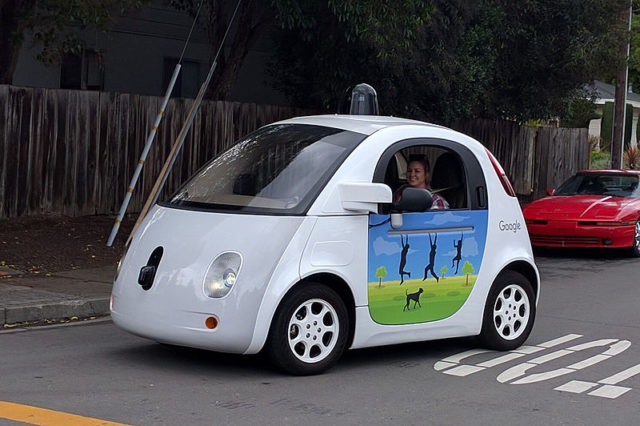
Cars of the Future: Driven by Policy or Technology?
November 14, 2016 — Blog
Imagine a scenario in the not too distant future where a car, hurtling down a road, is about to collide with a family stepping onto a pedestrian crossing. There are two choices: the car can swerve off the road to avoid a collision, crashing over a cliff and killing its occupants, or it can go straight ahead and hit the family, resulting in their likely death.
At present, that choice lies with the human (and legally responsible) driver of the car. Their choice is likely based on their life experience, split second reading of the road conditions, value for their own life versus the lives of others and blind instinct. There is no “right” answer and the outcome is not fixed.
In future, the choice could be made by a computer, with the decision programmed into the car’s automated navigation system as a line of code at the factory or from the latest software update. The outcome, or at least the parameters for determining it, would then be based on the technical, legal and ethical judgement of corporate professionals.

This extreme (and hopefully unlikely) example, or versions of it, have been recently been deliberated in the debate on the future of Connected and Autonomous Vehicles (CAVs). It raises a key point. The development of CAV technology – and many other aspects of Intelligent Mobility (IM) – will be governed as much by policy, regulations and ethical considerations as it is by innovation in hardware and software.
The current evidence is that policy makers, and the public who elect or influence them, are uncertain and conflicted on the way forward. Indeed, the development of the Internet is already raising concerns around privacy and protection of personal data, the benefits of innovation versus risks to public welfare, and huge uncertainty over the precise trajectories of future urban mobility. It is inevitable that these conundrums will mount up, as the functionality of data processing, communication, and the systems through which data flows, grows exponentially.
In the case of CAVs, governments are at various stages of allowing the testing of driverless prototypes on public roads. They also diverge on the conditions for how this testing should be carried out. Furthermore, implementing driverless vehicles also needs to be done in a manner that satisfies the research objectives of companies such as Google, Uber and Volvo, whilst assuring protection of other road users from still relatively immature systems. In the medium-term, once the technology is proven, decisions will need to be made on how and when the legal definition of a human driver can be substituted for an automated driving system, how driving laws should be re-written and the implications for personal liability and insurance in the event of accidents.
In the long-term, we also need to consider an ultimate end-point, a point when humans can be fully removed from the driving loop and manual vehicles discontinued and replaced by fully driverless cars without other manual controls at all. This is where Google’s approach differs from other automotive manufacturers who are betting on a progressive addition of driver assistance systems, function by function, but with human choice on whether and when to deploy them.

Will there be a “No Drive Day” around the 2050 when driving tests and licenses are discontinued and replaced by access rules and obligations for passengers within a driverless system? Will private vehicle ownership be fully replaced by universal Mobility as a Service accounts? Could travel itself be circumscribed or regulated on social and environmental grounds?
On technical evidence alone the arguments may be persuasive. After all, if CAV technology is theoretically capable of preventing 90 per cent of the annual one million plus fatalities from road accidents across the World, then shouldn’t governments be morally bound to implement it as quickly as possible? Will the end of the private car in favor of common (automated and electric) road fleets banish traffic congestion and pollution to a distant memory? Imagine safer roads, reliable journey times, improved air quality and more liveable cities all within reach if everyone gives up their right to own a car and manually drive it.
But we circle back to ethics and conflicting views on what is the “best” way forward. Recent public surveys in many countries show that people understand the potential benefits of new automotive technology, including preventing deaths and injuries on our roads. Yet, they prefer to have their own car and control their overall travel experience. Only a small minority believes that the right to drive should be withdrawn, irrespective of whether the technology enables it and the scale of the potential benefits. It is hard to imagine how such views will be overcome without extensive public debate, exposure and familiarization, market research to inform sensitive product design and possibly – but clearly not without controversy – strong leadership from politicians to regulate individual freedom to drive for the greater good.
Technology will transform road-based urban mobility in our lifetimes in a way not seen since the invention of the internal combustion engine in the nineteenth century. The first smartphone, an early enabler of Intelligent Mobility, was introduced a little over nine years ago. Yet research by Google, Baidu and other car manufacturers and technology companies could revolutionize the travel experience over the next 30. Policy makers and the public will have a major challenge to keep up, but this should not be used as an excuse for indecision, prevarication and inaction. They must certainly rise to the potential enabled by technological innovations, whilst directly addressing the difficult social, political and ethical issues. Once the technical evidence is clear, firm and timely, decisions will have to be made.